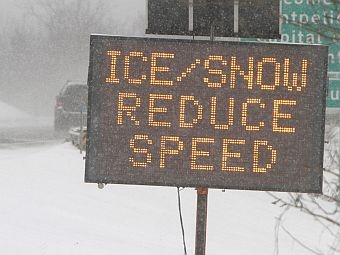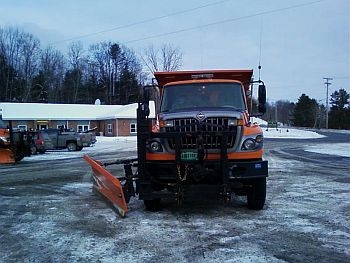 VPR’s Charlotte Albright paid a visit to a VTrans garage in St. Johnsbury to learn about the fine art of snowplowing. Trucks are now equipped with a computer screen showing how much salt and sand is being deposited and the speed of the spinner scattering it. But the new bells and whistles don’t make plowing easy.
VPR’s Charlotte Albright paid a visit to a VTrans garage in St. Johnsbury to learn about the fine art of snowplowing. Trucks are now equipped with a computer screen showing how much salt and sand is being deposited and the speed of the spinner scattering it. But the new bells and whistles don’t make plowing easy.
(Albright) State plow operator Gary McGinnis loves to see snow piling up, even though it could mean starting up his plow truck well before sunrise, in freezing cold temperatures, to clear treacherous highways.
(McGinnis) "You get a few beeps and stuff. Lets you know your gauges are all up and working. ‘Course we gotta fasten our seat belt. State law. I’ll look around, check my gauges, make sure everything’s good, check my mirrors, take my first lever, raise my front plow, then my other back levers will bring up the wing plow here."
(Albright) He’s grinning.
(McGinnis) "I don’t know if it’s the little kid in me that likes to play in the snow all the time, but I have a great time and it is a fun job for me. I like it a lot."
(Albright) McGinnis is responsible for about a 25-mile stretch of I-91, north and south, in the travel lane. Like every state plow truck, McGinnis’ is combination of an International Harvester cab and a rolling control room.
A computer screen near the dashboard shows him how much salt or sand he’s depositing, and the speed of the spinner that’s scattering it. Using levers and toggles, he can raise or lower the tarp covering the material, and control his plow blades. The front plow usually hugs the ground, except, for example, at railroad crossings, but the side wing can be lifted to move snow banks.
Another button sprays liquid chloride with the salt. A sensor tells him not just the air temperature, but the temperature of the pavement.
But all these bells and whistles don’t make plowing easy. Once, in the middle of a snow squall, in total darkness, a tractor-trailer got way too close.
(McGinnis) "His trailer came down and bumped my side mirror. It happened so fast. It was enough to shock you. Made you stop and think for a minute. It’s tough."
(Albright) McGinnis kept his truck on the road, but it was a scare.
 Like all plow drivers, McGinniss often has to commute to work on nearly impassable roads, and he’s often shocked at the way other motorists drive in storms.
Like all plow drivers, McGinniss often has to commute to work on nearly impassable roads, and he’s often shocked at the way other motorists drive in storms.
(McGinnis) "’Cause we know what it is, but if they only knew – and they come by you at 70, 75 miles an hour – if they only knew when they got to their destination what they’ve actually been driving on, it would blow their mind."
(Albright) For example what looks like bare, dark pavement is sometimes lethal black ice. Knowing the condition of a snowy, icy road used to involve a fair amount of guesswork, but these days, it’s become like a science.
(Albright) Inside the VTrans garage, Gary’s boss, Dennis Whitehill, opens a notebook with color-coded charts and graphs, showing the proper temperatures for using dry salt-above 20 degrees–or salt treated with liquid chloride-from 10 to 20. Below ten, he says, nothing melts snow and ice.
Sand is used much more sparingly than it used to be. Whitehill says studies show it’s harder on the environment -especially groundwater–than salt.
(Whitehill) "And if you put sand down, you gotta clean it up, it fills in our ditches, stuff like that. And also the traffic seems to drive for what you give ‘em for road conditions. You put sand out and it’s there, it kind of browns up the road. But I think a lot of times it gives traffic a false sense of security. Just because you got sand on it don’t mean it’s a lot safer to drive on it as if it’s white."
(Albright) Not long ago, Whitehill left his warm office and climbed into a plow truck, with Gary McGinnis in the passenger seat.
(Whitehill) "It’s been a while since I’ve driven a plow truck and I wanted to go for a ride and drive. Very seldom do I drive a plow truck. I would if I had to."
(Albright) "How’d it go? How’d it feel that day?"
(Whitehill) "I don’t know. Ask Gary."
(McGinnis) "He did a great job. I was impressed. He’s still got it in him."
(Albright) That’s after 23 years clearing roads through one of the snowiest belts in Vermont.
For VPR News, I’m Charlotte Albright in the Northeast Kingdom